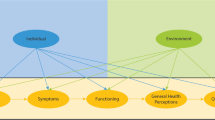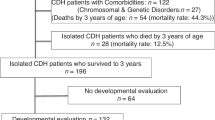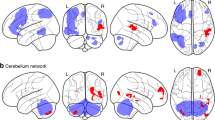Abstract
Object
To evaluate whether the results of the health-related quality of life (HRQOL) is associated with the various clinical aspects of intermittent exotropia in children.
Methods
The HRQOL of children and their parents was evaluated prospectively using the Intermittent Exotropia Questionnaire (IXTQ). The deviation angle, stereo function, sensory fusion, and strabismus control were measured.
Results
Two hundred and sixty six children with intermittent exotropia (aged 5–17 years) were included in the study. Child HRQOL was significantly correlated with clinical severity; lower IXTQ scores were associated with a larger deviation (p < 0.001 both for distance and near) and poorer Newcastle control scores (p < 0.001). Proxy child HRQOL was significantly correlated with the deviation (p < 0.001), Newcastle control scores (p < 0.001) and stereo function (p < 0.05). Parent HRQOL was associated with their child’s deviation (p < 0.01) and stereo function (p < 0.005). Multiple linear regression analysis suggested that the deviation angle at distance and the Newcastle control score at home were associated with the child’s HRQOL.
Conclusion
Both the child and their parents’ HRQOL showed a trend toward correlating with clinical severity. Large deviation, poor control, and poor stereo function were significantly associated with lower IXTQ scores. The deviation angle at distance and exotropia control at home were associated with the child’s HRQOL.
Similar content being viewed by others
Log in or create a free account to read this content
Gain free access to this article, as well as selected content from this journal and more on nature.com
or
References
Govindan M, Mohney BG, Diehl NN, Burke JP. Incidence and types of childhood exotropia, apopulation-based study. Ophthalmology. 2005;112:104–8.
Pan CW, Zhu H, Yu JJ, Ding H, Bai J, Chen J, et al. Epidemiology of intermittent exotropia in preschool children in China. Optom Vis Sci. 2016;93:57–62.
Fu J, Li SM, Liu LR, Li JL, Li SY, Zhu BD, Li H. et al. Prevalence of amblyopia and strabismus in a population of 7th-grade junior high school students in Central China:the Anyang Childhood Eye Study (ACES). Ophthalmic Epidemiol. 2014;21:197–203.
Chia A, Roy L, Seenyen L. Comitant horizontal strabismus: an Asian perspective. Br J Ophthalmol. 2007;91:1337–40.
Buck D, Powell C, Cumberland P, Davis H, Dawson E, Rahi J. et al. Present features early manag child inter exotropia UK: inception cohort. Br J Ophthalmol. 2009;93:1620–4.
Hatt SR, Mohney BG, Leske DA, Holmes JM. Variability of control in intermittent exotropia. Ophthalmology. 2008;115:371–6.
Hatt SR, Mohney BG, Leske DA, Holmes JM. Quantifying variability in the measurement of control in intermittent exotropia. J AAPOS. 2015;19:33–37.
Hatt SR, Mohney BG, Leske DA, Holmes JM. Variability of angle of deviation measurements in children with intermittent exotropia. J AAPOS. 2012;16:120–4.
Hatt SR, Leske DA, Holmes JM. Awareness of exodeviation in children with intermittent exotropia. Strabismus. 2009;17:101–6.
Yamada T, Hatt SR, Leske DA, Holmes JM. Health-related quality of life in parents of children with intermittent exotropia. J AAPOS. 2011;15:135–9.
Hatt SR, Leske DA, Adams WE, Kirgis PA, Bradley EA, Holmes JM. Quality of life in intermittent exotropia: child and parent concerns. Arch Ophthalmol. 2008;126:1525–9.
Yamada T, Hatt SR, Leske DA, Holmes JM. Specific health-related quality of life concerns in children with intermittent exotropia. Strabismus. 2012;20:145–51.
Lim SB, Wong WL, Ho RC, Wong IB. Childhood intermittent exotropia from a different angle: does severity affect quality of life? Br J Ophthalmol. 2015;99:1405–11.
Hatt SR, Leske DA, Yamada T, Bradley EA, Cole SR, Holmes JM. Development and initial validation of quality-of-life questionnaires for intermittent exotropia. Ophthalmology. 2010;117:163–8.
Hulley SB, Cummings SR, Browner WS, Grady D, Newman TB. Designing clinical research: an epidemiologic approach. 4th ed. Philadelphia, PA: Lippincott Williams & Wilkins; 2013. Page 79.
Guo DD, Wu JF, Hu YY, Sun W, Lv TL, Jiang WJ, et al. Stereoacuity and related factors: the Shandong Children Eye Study. PLoS ONE. 2016;11:e0157829 https://doi.org/10.1371/journal.pone.0157829
Haggerty H, Richardson S, Hrisos S, Strong NP, Clarke MP. The Newcastle Control Score: a new method of grading the severity of intermittent distance exotropia. Br J Ophthalmol. 2004;88:233–5.
Buck D, Hatt SR, Haggerty H, Hrisos S, Strong NP, Steen NI, et al. The use of the Newcastle Control Score in the management of intermittent exotropia. Br J Ophthalmol. 2007;91:215–8.
Zhu H, Xu S, Leng Z, Fu Z, Xiao Y, Liu H. Utilization of quality of life assessment questionnaire for intermittent exotropia in China. Chin J Ophthalmol. 2016;52:596–603.
Lukman H, Kiat JE, Ganesan A, Chua WL, Khor KL, Choong YF. Strabismus-related prejudice in 5-6-year-old children. Br J Ophthalmol. 2010;94:134–51.
Lukman H, Kiat JE, Ganesan A, Chua WL, Khor KL, Choong YF. Negative social reaction to strabismus in schoolchildren ages 8-12 years. J AAPOS. 2011;15:238–40.
Paysse EA, Steele EA, McCreery KM, Wilhelmus KR, Coats DK. The emergence of negative attitudes toward strabismus. J AAPOS. 2001;5:361–6.
Mojon-Azzi SM, Kunz A, Mojon DS. Strabismus and discrimination in children: are children with strabismus invited to fewer birthday parties? Br J Ophthalmol. 2011;95:473–6.
Uretmen O, Egrilmez S, Kose S, Pamukçu K, Akkin C, Palamar M. Negative social bias against children with strabismus. Acta Ophthalmol Scand. 2003;81:138–42.
Ahen SJ, Yang HK, Hwang JM. Binocular visual acuity in intermittent exotropia: role of accommodative convergence. Am J Ophthalmol. 2012;154:981–6.
Superstein R, Dean TW, Holmes JM, et al. Relationship among clinical factors in childhood intermittent exotropia. J AAPOS. 2017;21:268–73.
Hatt SR, Leske DA, Liebermann L, Mohney BG, Brodsky, Yamada T, et al. Associations between health-related quality of life and the decision to perform surgery for childhood intermittent exotropia. Ophthalmology. 2014;121:883–8.
Li Q, Bai J, Zhang J, Gong Q, Liu L. Assessment of cortical dysfunction in patients with intermittent exotropia: an fMRI study. PLoS One. 2016;11:e0160806
Chan ST, Tang KW, Lam KC, Chan LK, Mendola JD, Kwong KK. Neuroanatomy of adult strabismus: a voxel based morphometric analysis of magnetic resonance structural scans. Neuro Image. 2004;22:986–94.
Feng L, Zhou J, Chen L, Hess RF. Sensory eye balance in surgically corrected intermittent exotropes with normal stereopsis. Sci Rep. 2015;5:13075.
Mohney BG, Holmes JM. An office-based scale for assessing control in intermittent exotropia. Strabismus. 2006;14:147–50.
Hatt SR, Liebermann L, Leske DA, Mohney BG, Holmes JM. Improved assessment of control in intermittent exotropia using multiple measures. Am J Ophthalmol. 2011;152:872–6.
Buck D, Clarke MP, Haggerty H, Hrisos S, Powell C, Sloper J, et al. Grading the severity of intermittent distance exotropia: the revised Newcastle Control Score. Br J Ophthalmol. 2008;92:577.
Acknowledgements
This work is supported by Wenzhou Municipal Science and Technology Bureau (subject numbers: Y20160150; Y20170782) and Huzhou Municipal Science and Technology Bureau (subject number: 2017GYB13).
Author information
Authors and Affiliations
Corresponding author
Ethics declarations
Conflict of interest
The authors declare that they have no conflict of interest.
Additional information
Publisher’s note: Springer Nature remains neutral with regard to jurisdictional claims in published maps and institutional affiliations.
Rights and permissions
About this article
Cite this article
Wang, Y., Xu, M., Yu, H. et al. Health-related quality of life correlated with the clinical severity of intermittent exotropia in children. Eye 34, 400–407 (2020). https://doi.org/10.1038/s41433-019-0557-1
Received:
Revised:
Accepted:
Published:
Issue date:
DOI: https://doi.org/10.1038/s41433-019-0557-1
This article is cited by
-
Clinical research on the application of AI-assisted computing systems in the treatment of intermittent exotropia
BMC Ophthalmology (2025)
-
Reading ability in children with intermittent exotropia and its association with binocular visual function and visual information processing capability
BMC Ophthalmology (2025)
-
Visual and auditory attention defects in children with intermittent exotropia
Italian Journal of Pediatrics (2024)
-
Quality of life in intermittent exotropia for Korean children and their parents
BMC Ophthalmology (2023)
-
Effects of orthoptic therapy in children with intermittent exotropia after surgery: study protocol for a randomized controlled trial
Trials (2022)



